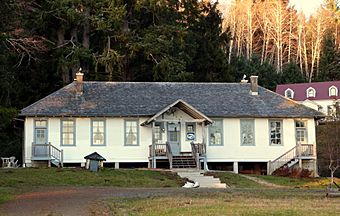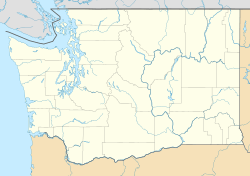Columbia River Quarantine Station facts for kids
Quick facts for kids |
|
|
Columbia River Quarantine Station
|
|
 |
|
| Nearest city | Knappton, Washington |
|---|---|
| Area | 1.8 acres (0.73 ha) |
| Built | 1899 |
| NRHP reference No. | 80004007 |
| Added to NRHP | February 8, 1980 |
The Columbia River Quarantine Station was a very important place in Knappton, Washington. It is now called the Knappton Cove Heritage Center. From 1899 to 1938, this station helped keep people safe from diseases. It checked ships and their passengers arriving at the Columbia River port. This station is the only one left on the West Coast of the United States. Other similar stations were burned down to stop diseases from spreading. In 1980, it became a part of the National Register of Historic Places.
Contents
Why Was the Columbia River Quarantine Station Built?
Keeping America Safe from Diseases
In the late 1800s, many people were moving to the United States. Rules for people entering the country became stricter. There were four main ports on the West Coast where immigrants could arrive. These were San Diego and San Francisco in California, Astoria, Oregon, and Port Townsend, Washington.
In 1891, a new law said that all arriving immigrants needed medical checks. If a ship coming to Astoria, Oregon had sick people, it had to travel 275 miles to Port Townsend for cleaning. This was a very long trip! People in Astoria and Portland wanted a closer place to check ships. But they did not want it too close to their cities. So, they suggested a spot across the river.
Finding the Right Spot for the Station
The perfect spot for the station was Knappton Cove. It used to be a fish cannery that was no longer in use. It already had a dock and some buildings. The government bought this land for US$8,000. This happened even though some people in Washington disagreed.
The station officially opened on May 9, 1899. The old cannery manager's house became the home for the station's caretaker. In 1900, a new building was built to clean ships. A hospital, also called a pesthouse, was added in 1912. This hospital was for sick crew members and passengers.
How Did the Quarantine Station Work?
Checking Ships and Passengers
When ships arrived at Astoria, they were checked for pests and diseases. If any problems were found, the ship went to Knappton Cove. Passengers would go ashore to take showers. Their clothes and bags were cleaned to remove any pests. Sick passengers were kept separate from others.
To clean the ships, workers burned pots of sulfur. This process took about 48 hours. At first, healthy crew and passengers slept in tents. They stayed there until their ship was clean. From 1915 to 1929, a ship called the USS Concord was docked at Knappton. It provided a place for people to stay during the cleaning process.
A Busy Place for Safety
In its first year, the station checked 6,120 people. These people came from 97 sailing ships and 35 steamships.
In 1921, a newspaper called The Sunday Oregonian wrote about the station. It said that every ship from a foreign country had to pass through quarantine. It called the station the "Ellis Island" for the Columbia River area. The article also said that thanks to the station's careful work, cities in the area had not experienced the plague.
During the 1920s, fewer immigrants came to the U.S. Also, new ways were found to clean ships while they were still docked. This meant the quarantine station was not needed as much. The Columbia River Quarantine Station closed down in 1938.
What Happened to the Station After It Closed?
New Uses for the Historic Site
After 1938, the Bureau of Lighthouses used the site for a short time. They used it to help guide ships. In 1942, the U.S. Public Health Service gave the station to the U.S. Coast Guard.
In 1950, the property was sold to Clarence and Katherine Bell. They were a family from Portland.
From Fishing Camp to Heritage Center
The Bell family turned the site into a fishing camp. It was called Knappton Cove Camp and operated in the 1950s. The camp closed in the 1960s. A big storm in 1971 destroyed the old dock.
In 1995, the station became a museum. It was named the Knappton Cove Heritage Center. Students helped to fix up the old buildings. Today, a non-profit group runs the museum. In 2017, they received a grant to help preserve this important historical site.



